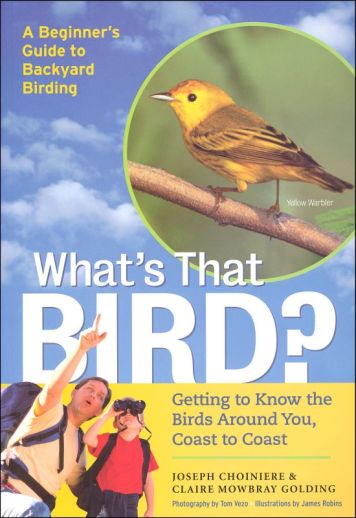We use cookies to make your experience better. To comply with the new e-Privacy directive, we need to ask for your consent to set the cookies. Learn more.
What's That Bird?
If you and your kids want to learn about birds, and I mean really learn about birds (more than the information provided by little books or field guides), then this is the book for you! Packed with full-color illustrations and photographs and detailed, yet easy-to-read information, bird lovers of all ages will learn something new. The book begins with an up-close-and-personal look at the bird. Learn the finer structures within feathers, types of feathers, bird anatomy and structure including bones and internal organs, types of bills, bird senses, and much more. The second chapter talks about the various places birds call home and which types prefer which environments and habitats. Bird communication, communities, nest preferences, eggs and food are all discussed. The third chapter is in a field guide layout introducing thirty types of birds with an introduction, size comparison, habitat, bird call, and range across the U.S.A. given. The section ends with a compact chart of all the birds discussed and the essential information about each one. Then students will learn about birds that are endangered and bird migration. The fifth chapter entails how you can interact with birds and make your yard a bird haven. There are some ideas for building projects such as nesting boxes and arbors, and ideas for keeping a calendar of the birds you see and when you see them to learn their schedules. The sixth and final chapter shows the gold-medal winning birds in lots of different events such as fastest runners, highest fliers, deepest divers, best dressed and more with short explanations of which bird species came in first. A glossary, resource list, index, and a short bird-watching quiz are all included in the appendix. So read up and head outside to put your new knowledge to the test! ~ Megan
If you and your kids want to learn about birds, then this is the curriculum for you! The text is packed with full-color illustrations and photographs and detailed, yet easy-to-read information, so bird lovers of all ages will learn something new. The book contains six chapters covering bird anatomy and structure, habitats, species, migration, attracting birds and more (for more information on this text, please see the full description in the Birds & Birdwatching - Informational/Textual Resources section). The Student Guide provides a study of the book. The Teacher's Key and Student Study Guide share a similar format, with the Teacher's Guide containing answers to all the fill-in-the-blank and comprehension questions. Non-reproducible. Available individually or as a set. Set includes one Student Guide and one Teacher Guide. Black & white illustrations. 25pgs. ~ Deanne / Megan
| Product Format: | Softcover Book |
|---|---|
| Grades: | 3-12 |
| Brand: | Storey Books |
| Author: | Joseph Choiniere & Claire Mowb |
| ISBN: | 9781580175548 |
| EAN/UPC: | 037038175547 |
| Length in Inches: | 11 |
| Width in Inches: | 7.5 |
| Height in Inches: | 0.375 |
| Weight in Pounds: | 1.05 |
Be the first to review this item


This bird book is the perfect companion to my purchase of binoculars.
Our 7 year old son wants to learn about birds. This looked like a fun, informative book.
looked interesting